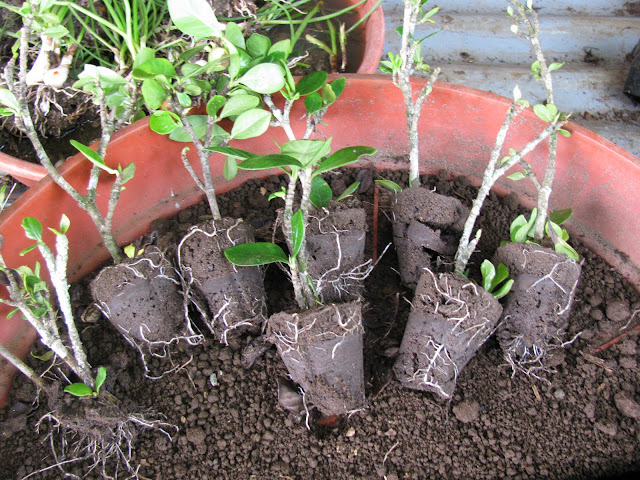About a month after making a whole variety of cuttings from Cordyline fruticosa (Ti Plant) to Gardenia jasminoides Gardenias and Ixora I am now starting transplanting the plants into individual poly bags or into the ground.
These Ti cuttings have different root development due to my having made the cuttings over a period of several weeks.
This is one of the nicest examples of root development that I had. There were about ten cuttings in a big poly bag of river sand. I also have ten smaller cuttings which I planted directly into 3/4 inch bags. The ones that were in the sand have been carefully transplanted along one side of the driveway. Earlier on I had planted a whole batch of cuttings directly into the bed on the otherside.
Here you can see the different stages of root development. Ideally I would have preferred to have them like the plant on the right. Now I know that I should leave them in for at least four weeks for the plants to develop roots of that extent. In any case all the Ti cuttings I prepared have survived.
However, next time I will make sure I do not mix cuttings started at different times in the same bag because the faster and better the root development the faster the plant will become established and grow. Unfortunately given the space available ... that is dog safe space I only had one big poly bag of river sand and another bag of soil.
For the Gardenias I used river silt in a seed tray 6 x 10 which gave me 60 plants per tray. I only did one tray because I was not sure what the result would be. In all I got 56 plants. The other 4 that did not make it were due to the silt being washed out of the holes and the cutting dying. So I would say that the success rate for rooting Gardenias is quite high.
For both the ti plants and the Gardenias I kept the sand or silt moist and in partial shade. I do not have a greenhouse / shadehouse or even shade cloth put up but although the area they were in gets some direct sun they are shaded by the house and a large mango tree and lemon tree.
River sand seems to work best in keeping the stems moist while providing good drainage. My main problem was keeping them from being disturbed which would damage the emerging rootlets.
Just today I discovered that one of the cats (Lamuja the mother cat) has just decided that one of the seed trays with hedge cuttings makes an ideal soft and cool spot to lie on.
I think that the Gardenias I have are Gardenia jasminoides but I am not 100% sure.
Here is an interesting plant I came across driving in Safatoa Lefaga. Apparently the Samoan name is Ava o le Pusi which means The Cat's Whiskers. I have not yet identified the plant. I was kindly given four young plants which are now recovering.
Flora and Fauna - Plants and Critters Blog by Vincent Albert Vermeulen is licensed under a Creative Commons Attribution-NonCommercial-ShareAlike 3.0 Unported License.
Based on a work at http://plantsandcritters.blogspot.be/.
Permissions beyond the scope of this license may be available at http://plantsandcritters.blogspot.be/.
Additional
information:
·
Flora and
Fauna - Plants and Critters (on plants, animals as well as gardening,
conservation and environmental matters)
·
The Blood
of Souls (language,
translation and etymology)
·
Whiskers on
Kittens (Life with Kittens and Cats in general)
References
Whistler, W. Arthur, “Wayside Plants of the Islands. A Guide
to the Lowland Flora of the Pacific Islands including Hawai’i Samoa Tonga
Tahiti Fiji Guam Belau”, Isle Botanica, Honolulu, 1995.
ISBN
0-9645426-0-9







nice info ...thanks
ReplyDeleteYou are welcome Jiwa Tani.
DeleteI hope it was useful